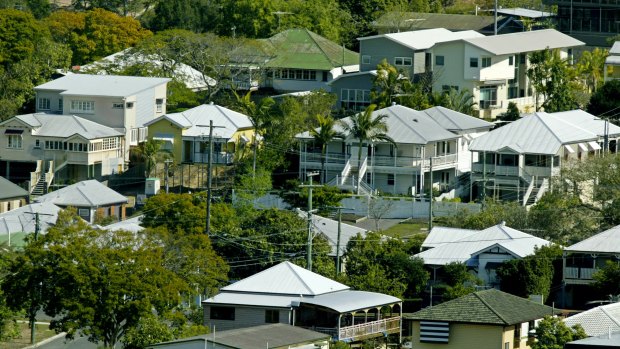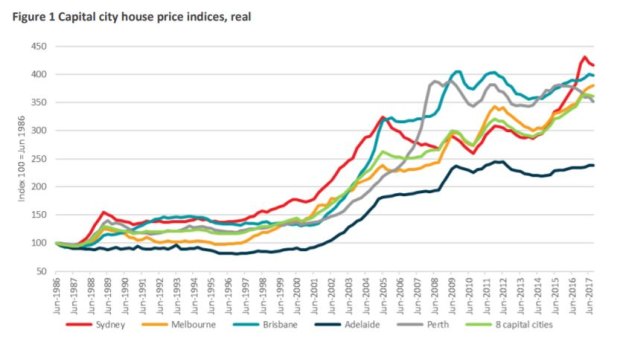This was published 6 years ago
Brisbane house prices have increased almost 300 per cent in three decades
Brisbane house prices have increased about 299 per cent in real terms since 1986, driven by the cost of land rather than the quality of housing.
Brisbane was second only to Sydney in terms of increases, and above the average of Australia's eight capital cities.

Since the 1960s, there has been a sustained rise in house prices in all capital cities, in contrast with the previous 70 years, in which real house prices did not increase in Sydney and Melbourne, and generally internationally. Credit: Glenn Hunt
However, Queensland's real prices had changed little since 2009 and outside of the south-east, they generally fell.
The findings were made in a staff research paper into housing affordability by Matt Geck and Sean Mackay, released by the Queensland Productivity Commission.
Most of the increases in Brisbane house prices occurred in two bursts, between 1987 and 1992, and particularly between 2001 and 2009.
Since 2007, 11 of the 12 Queensland local government areas that experienced the strongest house price growth were in south-east Queensland, with prices increasing the most in Brisbane.
The authors found the state's housing affordability, measured as the ratio of income to house prices, deteriorated considerably from the 1980s, but had roughly stabilised since about 2010.
Over the past five years, housing affordability across Queensland, measured as a proportion of income, had improved for median households, both in terms of rents and mortgage repayments.
However, housing affordability varied considerably across the state.

Capital city house prices from 1986 to 2017, in real terms.Credit: Queensland Productivity Commission
The Gold Coast, Sunshine Coast and Wide Bay were among the least affordable in terms of rents and house prices to incomes, and central Queensland, Mackay and the Queensland outback were the most affordable.
However, international studies using house price-to-income ratios suggested housing in Queensland was relatively unaffordable.
The Demographia International Housing Affordability Survey found Brisbane's urban housing market to be less affordable than major markets in Singapore, Canada (except for Toronto and Vancouver), Ireland, the US (except for Miami, several Californian cities and Honolulu) and Japan.
Toowoomba, Bundaberg, Cairns, Brisbane, Fraser Coast, Gold Coast and Sunshine Coast were all ranked as having severely unaffordable housing markets.
In Queensland, 17.4 per cent of households paid more than 30 per cent of their income in housing costs.
Housing affordability problems were most acute for younger people and lower-income earners, with more than one-third of low-income households in rental stress.
Deposit requirements were the biggest barrier to home ownership, rather than the ongoing costs of mortgage repayments, the authors found.
Over the past 50 years, the gap between incomes and home deposits had increased significantly.
On average, households require 1.1 years of household income to generate a 20 per cent deposit in Brisbane, up from about 0.7 years 15 years earlier.
Queensland's housing stock was dominated by houses, at 74 per cent, but that was slowly changing.
Younger people, families and couples were increasingly living in townhouses and apartments, while older people tended to stay in houses rather than downsizing.
A decline in home ownership in Queensland was most evident among younger people, with households aged 65 and over the only age group for which home ownership had not fallen since 2006.
The fall was largest among households aged 25 to 34, for which home ownership fell from 49.4 per cent to 42.4 per cent.
Housing prices were not the only reason for falling home ownership among younger people, with other reasons delayed partnering and child-rearing, higher rates of study, part-time employment and some young people placing a higher premium on mobility and therefore choosing to rent.
The authors said governments significantly affected housing markets, with efforts best-focused on ensuring policies did not unduly affect housing supply and demand, with key policies including tax and planning.
Queensland Housing Minister Mick de Brenni said the government had established the Housing Research Alliance to examine the question of what was genuinely affordable.
"The measures we currently use to define affordable housing are not robust, and gaining a true measure of what is genuinely affordable is key to shaping policy settings that encourage development of affordable housing in Queensland," he said.
"Ultimately this is a national issue that needs to be addressed at a federal level."
Mr de Brenni called for action on negative gearing and capital gains tax.